tow MAZDA MODEL CX-5 2017 - RHD (UK, Australia) (in English) Owner's Guide
[x] Cancel search | Manufacturer: MAZDA, Model Year: 2017, Model line: MODEL CX-5, Model: MAZDA MODEL CX-5 2017Pages: 772, PDF Size: 19.35 MB
Page 345 of 772
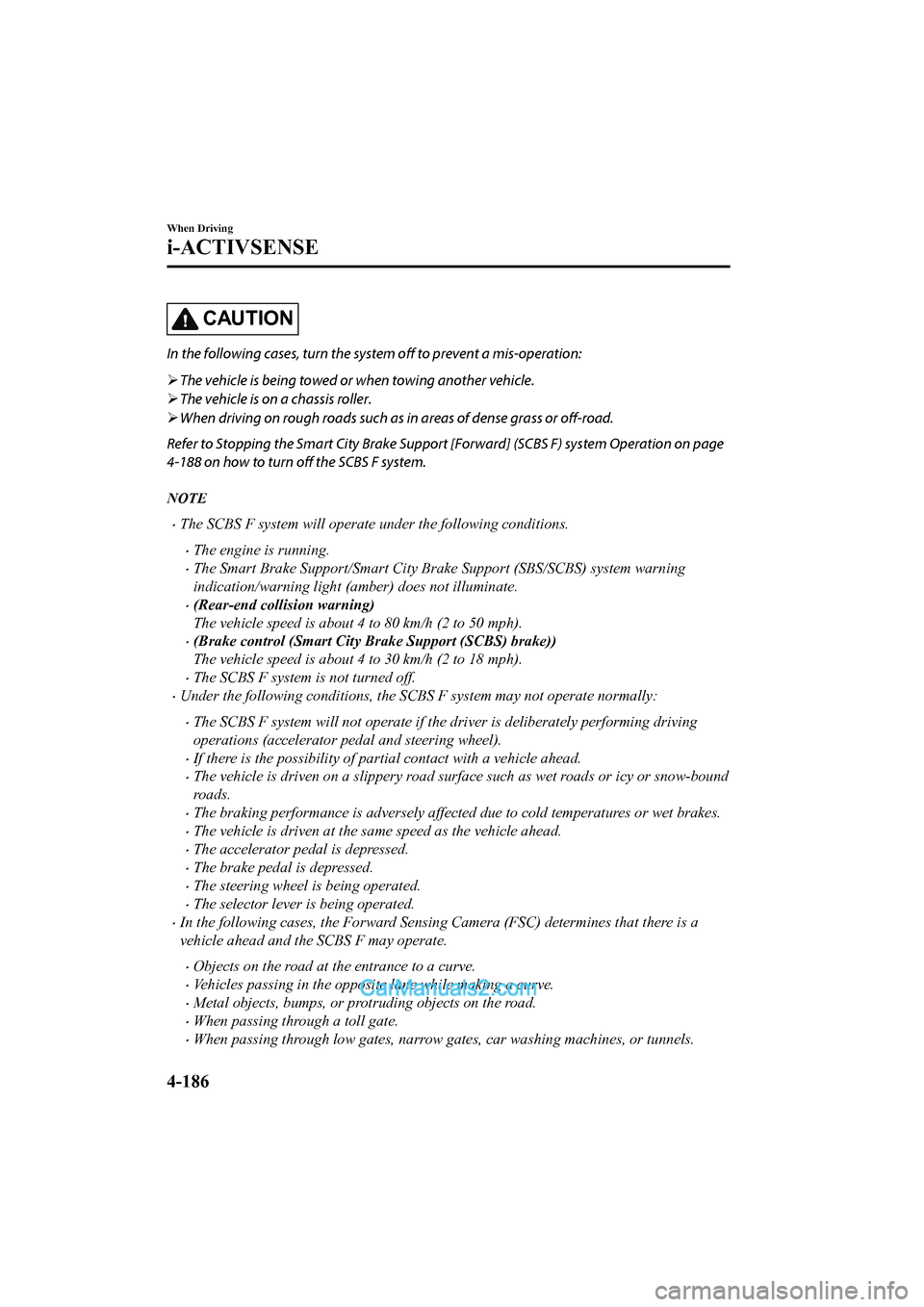
CAUTION
In the following cases, turn the system off to prevent a mis-operation:
The vehicle is being towed or when towing another vehicle.
The vehicle is on a chassis roller.
When driving on rough roads such as in areas of dense grass or off-road.
Refer to Stopping the Smart City Brake Support [Forward] (SCBS F) system Operation on page
4-188 on how to turn off the SCBS F system.
NOTE
•The SCBS F system will operate under the following conditions.
•The engine is running.
•The Smart Brake Support/Smart City Brake Support (SBS/SCBS) system warning
indication/warning light (amber) does not illuminate.
•(Rear-end coll ision warning)
The vehicle speed is about 4 to 80 km/h (2 to 50 mph).
•(Brake control (Smart City Brake Support (SCBS) brake))
The vehicle speed is about 4 to 30 km/h (2 to 18 mph).
•The SCBS F system is not turned off.
•Under the following conditions, the SCBS F system may not operate normally:
•The SCBS F system will not operate if the dr iver is deliberately performing driving
operations (accelerator pedal and steering wheel).
•If there is the possibility of pa rtial contact with a vehicle ahead.
•The vehicle is driven on a slippery road surface such as wet roads or icy or snow-bound
roads.
•The braking performance is adversely affected due to cold temperatures or wet brakes.
•The vehicle is driven at the same speed as the vehicle ahead.
•The accelerator pedal is depressed.
•The brake pedal is depressed.
•The steering wheel is being operated.
•The selector lever is being operated.
•In the following cases, the Forward Sensing Camera (FSC) determines that there is a
vehicle ahead and the SCBS F may operate.
•Objects on the road at the entrance to a curve.
•Vehicles passing in the opposite lane while making a curve.
•Metal objects, bumps, or protruding objects on the road.
•When passing through a toll gate.
•When passing through low gates, narrow gates, car washing machines, or tunnels.
When Driving
i-ACTIVSENSE
4-186
2017-6-7 7:51:19 Form No. CX-5 8FY4-EE-17E+L_Edition2
Page 350 of 772

•The height of the obstruction is high such as trucks with high loading platforms.
•The obstruction is small.
•The obstruction is thin such as a signpost.
•The obstruction is positioned away from the centre of the vehicle.
•The surface of the obstruction is not pointed vertically relative to the vehicle.
•The obstruction is soft such as a hanging curtain or snow stuck to a vehicle.
•The obstruction is shaped irregularly.
•The obstruction is extremely close.
•In the following cases, the ultrasonic sensors (rear) cannot detect obstructions correctly
and the SCBS R may not operate.
•Something is stuck on the bumper near an ultrasonic sensor (rear).
•The steering wheel is turned sharply, or the brake or accelerator pedal is operated.
•There is another obstruction near one obstruction.
•During inclement weather such as rain, fog and snow.
•High or low humidity.
•High or low temperatures
•Strong winds.
•The path of travel is not flat.
•Heavy luggage is loaded in the luggage compartment or on the rear seat.
•Objects such as a wireless aerial, fog light , or illuminated number plate is installed
near an ultrasonic sensor (rear).
•The orientation of an ultrasonic sensor (rear) has deviated for reasons such as a
collision.
•The vehicle is affected by other sound waves such as the horn, engine noise, ultrasonic
sensor of another vehicle.
•In the following cases, an ultrasonic sensor (rear) may detect something as a target
obstruction which could cause the SCBS R system to operate.
•Driving on a steep slope.
•Wheel blocks.
•Hanging curtains, gate poles such as at toll gates and railroad crossing.
•When travelling near objects such as foliage, barriers, vehicles, walls, and fences along
a road.
•When driving off-road in areas where there is grass and forage.
•When passing through low gates, narrow gates, car washing machines, and tunnels.
•A towing bar is installed or a trailer is connected.
•(Manual transaxle)
If the vehicle is stopped by the Smart City Brake Support (SCBS) operation and the clutch
pedal is not depressed, the engine stops.
•When the system operates, the user is no tified by the multi-information display.
When Driving
i-ACTIVSENSE
4-191
2017-6-7 7:51:19 Form No. CX-5 8FY4-EE-17E+L_Edition2
Page 352 of 772
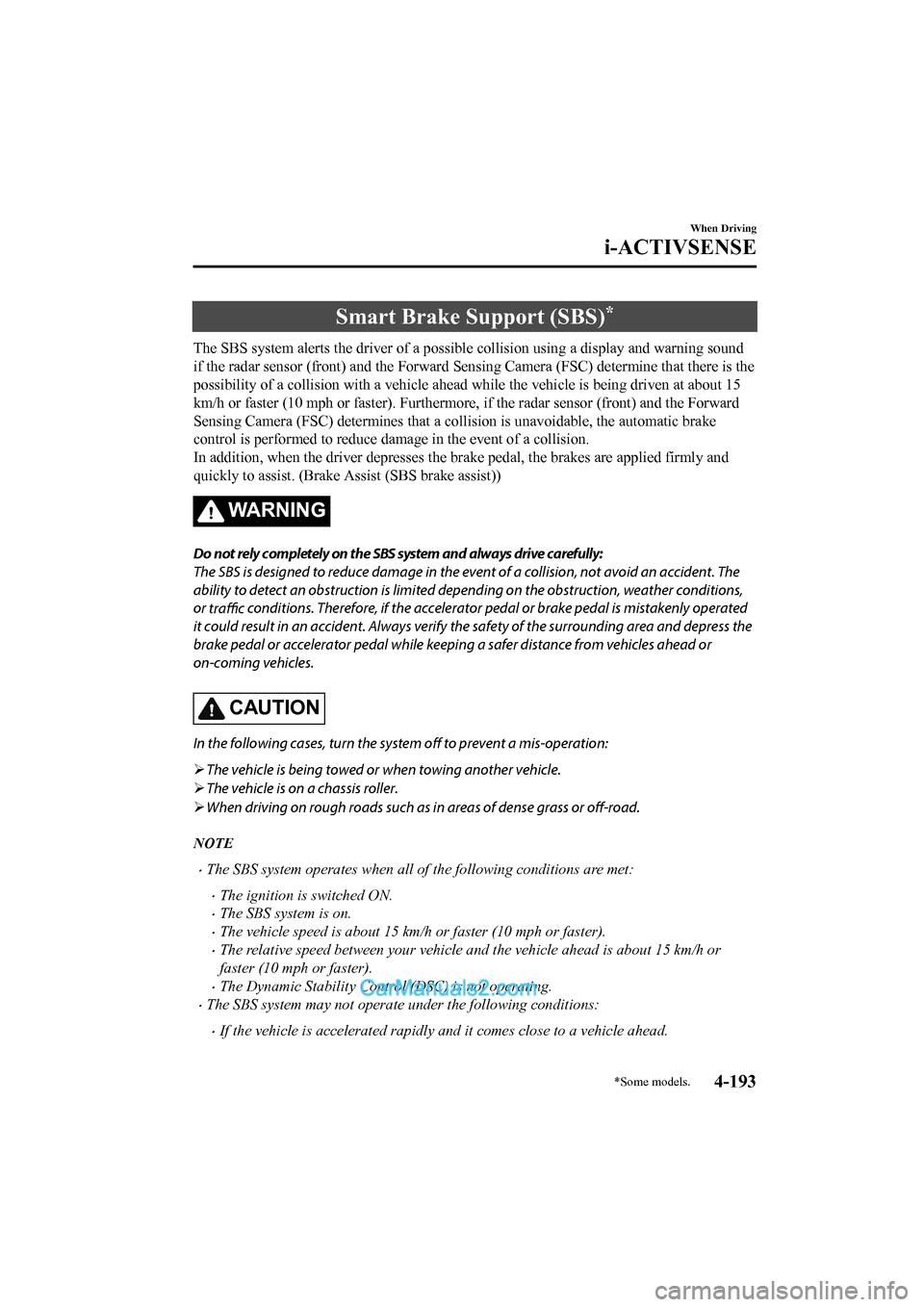
Smart Brake Support (SBS)*
The SBS system alerts the driver of a possible collision using a display and warning sound
if the radar sensor (front) and the Forward Sens ing Camera (FSC) determine that there is the
possibility of a collision with a vehicle ahead while the vehicle is being driven at about 15
km/h or faster (10 mph or faster). Furthermore, if the radar se nsor (front) and the Forward
Sensing Camera (FSC) determines that a collision is unavoidable, the automatic brake
control is performed to reduce d amage in the event of a collision.
In addition, when the driver depresses the brake pedal, the bra kes are applied firmly and
quickly to assist. (Brake Assist (SBS brake assist))
WA R N I N G
Do not rely completely on the SBS system and always drive carefully:
The SBS is designed to reduce damage in the ev ent of a collision, not avoid an accident. The
ability to detect an obstruction is limited de pending on the obstruction, weather conditions,
or traffic conditions. Therefore, if the accelerator pe
dal or brake pedal is mistakenly operated
it could result in an accident. Always verify th e safety of the surrounding area and depress the
brake pedal or accelerator pedal while keepin g a safer distance from vehicles ahead or
on-coming vehicles.
CAUTION
In the following cases, turn the system off to prevent a mis-operation:
The vehicle is being towed or when towing another vehicle.
The vehicle is on a chassis roller.
When driving on rough roads such as in areas of dense grass or
off-road.
NOTE
•The SBS system operates when all of the following conditions are met:
•The ignition is switched ON.
•The SBS system is on.
•The vehicle speed is about 15 km/h or faster (10 mph or faster).
•The relative speed between your vehicle and the vehicle ahead is about 15 km/h or
faster (10 mph or faster).
•The Dynamic Stability Control (DSC) is not operating.
•The SBS system may not operate under the following conditions:
•If the vehicle is accelerated rapidly and it comes cl ose to a vehicle ahead.
When Driving
i-ACTIVSENSE
*Some models.4-193
2017-6-7 7:51:19 Form No. CX-5 8FY4-EE-17E+L_Edition2
Page 358 of 772

•Elongated luggage or cargo is loaded onto installed roof rails and covers the Forward
Sensing Camera (FSC).
•Exhaust gas from the vehicle in front, sand, snow, and water vapour rising from
manholes and grating, and water splashed into the air.
•When towing a malfunctioning vehicle.
•The vehicle is driven with tyres having significantly different wear.
•The vehicle is driven on down slopes or bumpy roads.
•There are water puddles on the road.
•The surroundings are dark such as during the night, early evening, or early morning, or
in a tunnel or indoor parking lot.
•The illumination brightness of the headlights is reduced or the headlight illumination is
weakened due to dirt or a deviated optical axis.
•The target object enters the blind spot of the Forward Sensing Camera (FSC).
•A person or object bursts onto the road from the shoulder or cuts right in front of you.
•You change lanes and approach a vehicle ahead.
•When driving extremely close to the target object.
•Tyre chains or a temporary spare tyre is installed.
•The vehicle ahead has a special shape. For example, a vehicle towing a trailer house or
a boat, or a vehicle carrier carrying a vehicle with its front pointed rearward.
•If the Forward Sensing Camera (FSC) cannot operate normally due to backlight or fog,
the system functions related to the Forward Sensing Camera (FSC) are temporarily
stopped and the following warning lights turn on. However, this does not indicate a
malfunction.
•High Beam Control System (HBC) warning light (amber)
•Adaptive LED Headlights (ALH) warning light (amber)
•Lane-keep Assist System (LAS) & Lane Departure Warning System (LDWS) warning
light
•Mazda Radar Cruise Control with Stop & Go function (MRCC with Stop & Go
function) warning indication
•Smart Brake Support/Smart City Brake Support (SBS/SCBS) warning light (amber)
•If the Forward Sensing Camera (FSC) cannot operate normally due to high temperatures,
the system functions related to the Forward Sensing Camera (FSC) are temporarily
stopped and the following warning lights turn on. However, this does not indicate a
malfunction. Cool down the area around the Forward Sensing Camera (FSC) such as by
turning on the air conditioner.
•High Beam Control System (HBC) warning light (amber)
•Adaptive LED Headlights (ALH) warning light (amber)
When Driving
i-ACTIVSENSE
4-199
2017-6-7 7:51:19 Form No. CX-5 8FY4-EE-17E+L_Edition2
Page 389 of 772

•The vehicle is driven on bumps, inclines, gravel, or grass covered roads.
•Anything which generates ultrasound is near the vehicle, such as another vehicle's
horn, the engine sound of a motorcycle, the air brake sound of a large-sized vehicle, or
another vehicle's sensors.
•The vehicle is driven in heavy rain or in road conditions causing water-splash.
•A commercially-available wing pole or an aerial for a radio transmitter is installed to
the vehicle.
•The vehicle is moving towards a tall or square curbstone.
•An obstruction is too close to the sensor.
•Obstructions under the bumper may not be detected. Obstructions that are lower than the
bumper or thin which may have been initially detected but are no longer detected as the
vehicle approaches more closely.
•The following types of obstructions may not be detected:
•Thin objects such as wire or rope
•Things which absorb sonic waves easily such as cotton or snow
•Angular shaped objects
•Very tall objects, and those which are wide at the top
•Small, short objects
•Always have the system inspected at an expert repairer, we recommend an Authorised
Mazda Repairer if any shock is applied to the bumpers, even in a minor accident. If the
sensors are deviated, they cannot detect obstructions.
•The system may have a malfunction if the b eep does not operate or the indicator light
does not illuminate when the park assist sensors switch is turned on. Consult an expert
repairer, we recommend an Authorised Mazda Repairer.
•The system may have a malfunction if the beep sound which indicates a system
malfunction is heard and the indicator light flashes. Consult an expert repairer, we
recommend an Authorised Mazda Repairer.
•The beeper which indicates a system malfunction may not be heard if the ambient
temperature is extremely cold, or mud, ice, or snow adheres to the sensor area. Remove
any foreign material from the sensor area.
•When installing a trailer hitch, consult an expert repairer, we recommend an Authorised
Mazda Repairer.
When Driving
Parking Sensor System
4-230
2017-6-7 7:51:19 Form No. CX-5 8FY4-EE-17E+L_Edition2
Page 459 of 772
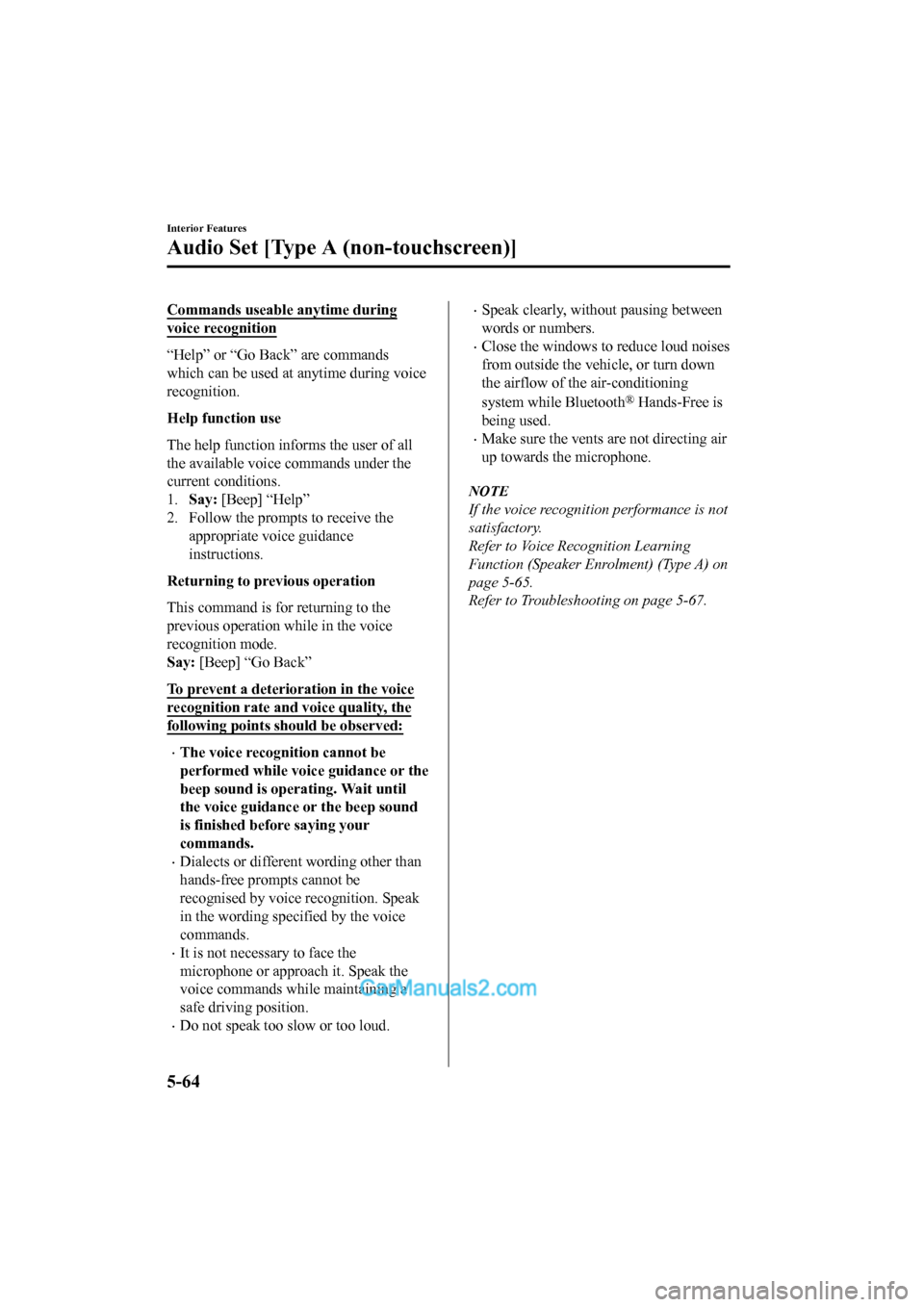
Commands useable anytime during
voice recognition
“Help” or “Go Back” are commands
which can be used at anytime during voice
recognition.
Help function use
The help function informs the user of all
the available voice commands under the
current conditions.
1.Say: [Beep] “Help”
2. Follow the prompts to receive the
appropriate voice guidance
instructions.
Returning to previous operation
This command is for returning to the
previous operation while in the voice
recognition mode.
Say: [Beep] “Go Back”
To prevent a deterio ration in the voice
recognition rate and voice quality, the
following points should be observed:
•The voice recognition cannot be
performed while voic e guidance or the
beep sound is operating. Wait until
the voice guidance or the beep sound
is finished before saying your
commands.
•Dialects or different wording other than
hands-free prompts cannot be
recognised by voice recognition. Speak
in the wording specified by the voice
commands.
•It is not necessary to face the
microphone or approach it. Speak the
voice commands while maintaining a
safe driving position.
•Do not speak too slow or too loud.
•Speak clearly, without pausing between
words or numbers.
•Close the windows to reduce loud noises
from outside the vehicle, or turn down
the airflow of the air-conditioning
system while Bluetooth
® Hands-Free is
being used.
•Make sure the vents are not directing air
up towards the microphone.
NOTE
If the voice recognition performance is not
satisfactory.
Refer to Voice Recognition Learning
Function (Speaker Enrolment) (Type A) on
page 5-65.
Refer to Troubleshooting on page 5-67.
Interior Features
Audio Set [Type A (non-touchscreen)]
5-64
2017-6-7 7:51:19 Form No. CX-5 8FY4-EE-17E+L_Edition2
Page 513 of 772

Voice Recognition
▼Basic Operation Method
Activating Voice Recognition
Press the talk button.
Ending Voice Recognition
Use one of the following methods:
•Press the hang-up button.
•Say, “Cancel”.
•Operate the commander switch or the
centre display (only when vehicle is
stopped).
Skipping Voice Guidance (for faster
operation)
Press and release the talk button.
Troubleshooting for Voice Recognition
If you do not understand an operation
method while in the voice recognition
mode, say “Tutorial” or “Help”.
Commands useable anytime during
voice recognition
“Go Back” and “Cancel” are commands
which can be used at anytime during voice
recognition.
Returning to previous operation
To return to the previous operation, say,
“Go Back” while in voice recognition
mode.
Cancel
To put the Bluetooth
® Hands-Free system
in standby mode, say, “Cancel” while in
voice recognition mode.
To prevent a deterioration in the voice
recognition rate and voice quality, the
following points should be observed:
•The voice recognition cannot be
performed while voi ce guidance or the
beep sound is operating. Wait until
the voice guidance or the beep sound
is finished before saying your
commands.
•Phone related commands are available
only when your phone is connected via
Bluetooth
®. Make sure your phone is
connected via Bluetooth
® before you
operate phone related voice commands.
•Music play commands, such as Play
Artist and Play Album can be used only
in USB audio mode.
•Do not speak too sl owly or loudly (no
loud voice).
•Speak clearly, without pausing between
words or numbers.
•Dialects or different wording other than
hands-free prompts cannot be
recognised by voice recognition. Speak
in the wording specified by the voice
commands.
•It is not necessary to face the
microphone or approach it. Speak the
voice commands while maintaining a
safe driving position.
•Close the windows and/or the sunroof to
reduce loud noises from outside the
vehicle, or turn dow n the airflow of the
air-conditioning system while
Bluetooth
® Hands-Free is being used.
•Make sure the vents are not directing air
up towards the microphone.
Interior Features
Audio Set [Type B (touchscreen)]
5-118
2017-6-7 7:51:19 Form No. CX-5 8FY4-EE-17E+L_Edition2
Page 527 of 772
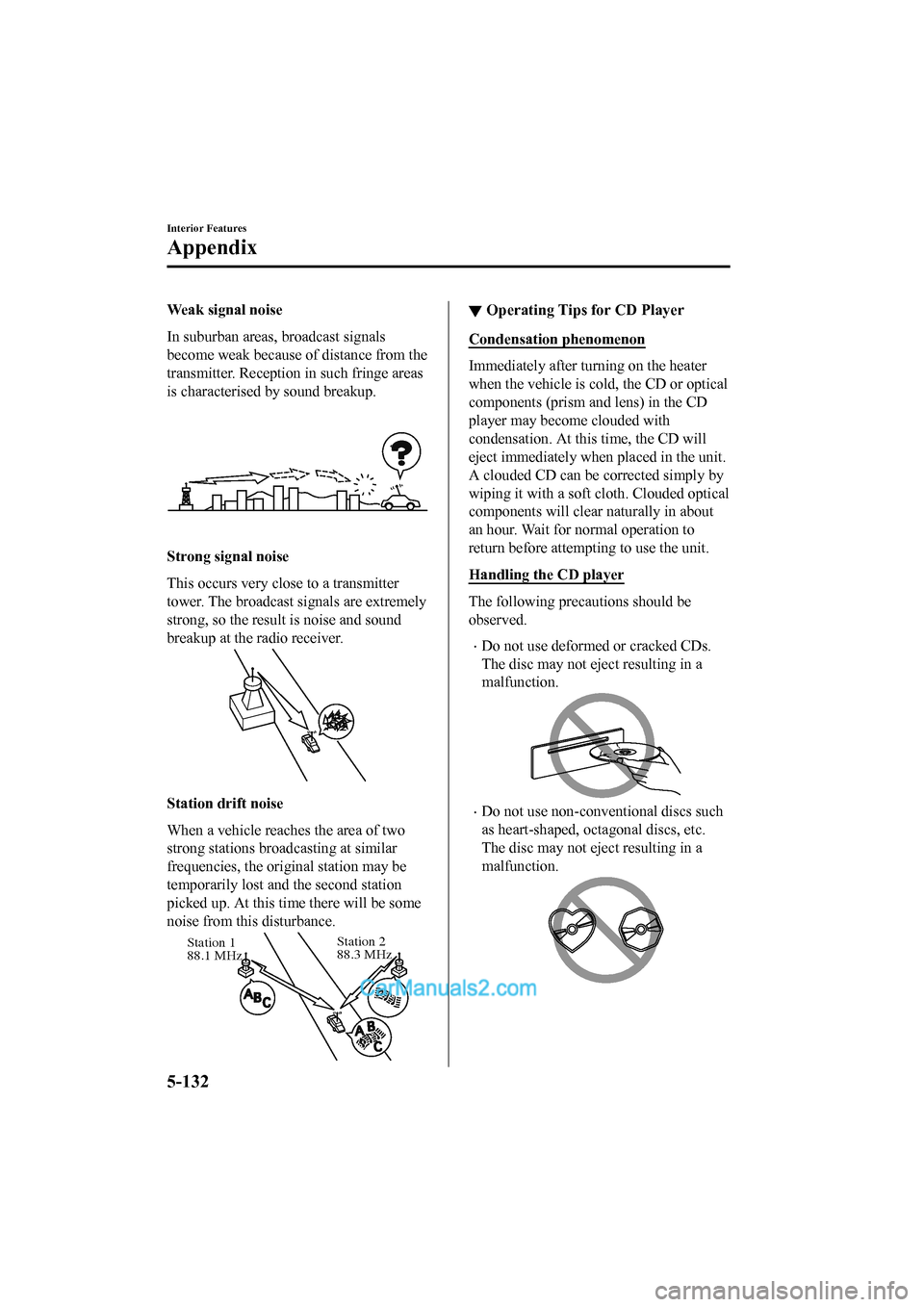
Weak signal noise
In suburban areas, broadcast signals
become weak because of distance from the
transmitter. Reception in such fringe areas
is characterised by sound breakup.
Strong signal noise
This occurs very close to a transmitter
tower. The bro adcast signals are extremely
strong, so the result is noise and sound
breakup at the radio receiver.
Station drift noise
When a vehicle reaches the area of two
strong stations broadcasting at similar
frequencies, the original station may be
temporarily lost and the second station
picked up. At this time there will be some
noise from this disturbance.
Station 2
88.3 MHz
Station 1
88.1 MHz
▼
Operating Tips for CD Player
Condensation phenomenon
Immediately after turning on the heater
when the vehicle is cold, the CD or optical
components (prism and lens) in the CD
player may become clouded with
condensation. At thi
s time, the CD will
eject immediately when placed in the unit.
A clouded CD can be corrected simply by
wiping it with a soft cloth. Clouded optical
components will clear naturally in about
an hour. Wait for normal operation to
return before attempting to use the unit.
Handling the CD player
The following precau tions should be
observed.
•Do not use deformed or cracked CDs.
The disc may not eject resulting in a
malfunction.
•Do not use non-conventional discs such
as heart-shaped, octagonal discs, etc.
The disc may not eject resulting in a
malfunction.
Interior Features
Appendix
5-132
2017-6-7 7:51:19 Form No. CX-5 8FY4-EE-17E+L_Edition2
Page 544 of 772

▼Glove Compartment
To open the glove compartment, pull the
latch toward you.
To close the glove compartment, firmly
press in the centre of the glove
compartment lid.
▼Centre Console
To open, pull the release latch.
Storage tray
The storage tray can be removed.
Storage tray
▼
Armrest Box*
To open, push the button and pull up the
lid.
Interior Features
Interior Equipment
*Some models.5-149
2017-6-7 7:51:19 Form No. CX-5 8FY4-EE-17E+L_Edition2
Page 618 of 772
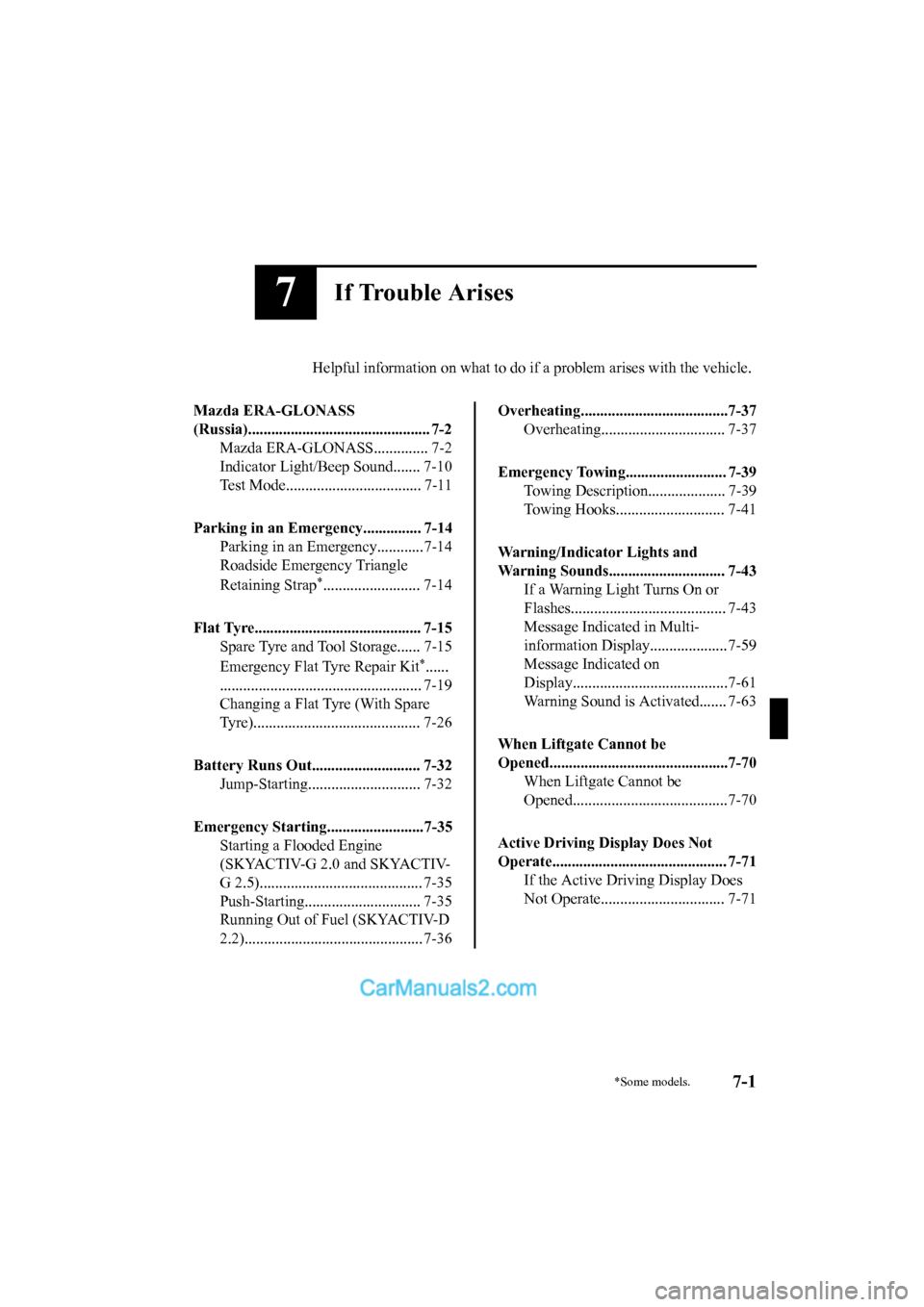
7If Trouble Arises
Helpful information on what to do if a problem arises with the vehicle.
Mazda ERA-GLONASS
(Russia)............................................... 7-2 Mazda ERA-GLONASS.............. 7-2
Indicator Light/Beep Sound....... 7-10
Test Mode................................... 7-11
Parking in an Emergency............... 7-14 Parking in an Emergency............7-14
Roadside Emergency Triangle
Retaining Strap
*......................... 7-14
Flat Tyre........................................... 7-15 Spare Tyre and Tool Storage...... 7-15
Emergency Flat Tyre Repair Kit
*......
.................................................... 7-19
Changing a Flat Tyre (With Spare
Tyre)........................................... 7-26
Battery Runs Out............................ 7-32 Jump-Starting............................. 7-32
Emergency Starting.........................7-35 Starting a Flooded Engine
(SKYACTIV-G 2.0 and SKYACTIV-
G 2.5).......................................... 7-35
Push-Starting.............................. 7-35
Running Out of Fuel (SKYACTIV-D
2.2).............................................. 7-36
Overheating......................................7-37
Overheating................................ 7-37
Emergency Towing.......................... 7-39 Towing Description.................... 7-39
Towing Hooks......... ................... 7-41
Warning/Indicator Lights and
Warning Sounds.............................. 7-43 If a Warning Light Turns On or
Flashes........................................ 7-43
Message Indicated in Multi-
information Display.................... 7-59
Message Indicated on
Display........................................7-61
Warning Sound is Activated....... 7-63
When Liftgate Cannot be
Opened..............................................7-70 When Liftgate Cannot be
Opened........................................7-70
Active Driving Display Does Not
Operate............................................. 7-71 If the Active Driving Display Does
Not Operate................................ 7-71
*Some models.7-1
2017-6-7 7:51:19 Form No. CX-5 8FY4-EE-17E+L_Edition2